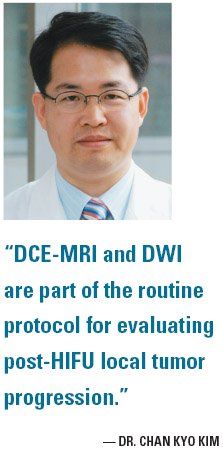MRI can monitor the prostate for local progression after ultrasonic ablation
High-intensity focused ultrasonic (HIFU) ablation is used to manage localized prostate cancer after external beam radiation therapy. But post-treatment alterations to prostate zonal anatomy hamper the assessment of local tumor progression in order to make decisions about second-line treatment. An interdisciplinary group from South Korea tested two MRI techniques for predicting local tumor progression.
ABSTRACT: Better sensitivity with dynamic contrast-enhanced MRI, better specificity with T2-weighted MRI with diffusion weighted imaging.
High-intensity focused ultrasonic (HIFU) ablation is used to manage localized prostate cancer after external beam radiation therapy. But post-treatment alterations to prostate zonal anatomy hamper the assessment of local tumor progression in order to make decisions about second-line treatment. An interdisciplinary group from South Korea tested two MRI techniques for predicting local tumor progression.

“Prostate cancer has a lower apparent diffusion coefficient (ADC) than noncancerous prostate tissue,” explained Chan Kyo Kim MD, and colleagues from Samsung Medical Center, Seoul. “The purpose of this study was to compare the diagnostic performance of dynamic contrast-enhanced MRI (DCE-MRI) with that of T2-weighted MRI with diffusion weighted imaging (DWI)” (Am J Roentgenol 190:1180-1186, 2008).
Between 2004 and 2006, 27 patients underwent transurethral prostate resection and endorectal HIFU. These patients had clinical stage T1-2 disease, no evidence of metastases, and a pre-ablation mean PSA of 7.25 ng/mL. PSA levels continued to rise after treatment.
Based on biopsy results, local tumor progression was found in 33% of the 162 prostate sectors. The diagnostic performance of DCE-MRI and DWI varied, with DCE-MRI delivering better

sensitivity and DWI better specificity. Accuracy rates for both readers and techniques were similar. False-positive results were higher for DCE-MRI vs DWI.
In an interview with ONI, Dr. Kim said that “DCE-MRI and DWI are part of the routine protocol for evaluating post-HIFU local tumor progression.” He added that the urologists who performed the ablation procedures did rely on imaging information as well as clinical and histopathological results.
Commenting on the study, Robert Bard, MD, associate professor of radiology, of New York Medical College, Valhalla, praised the researchers for highlighting the differences between the two MRI techniques. But despite the results in favor of MRI, the modality is not adept at distinguishing between treated and untreated tissue as well as inflammation and cancer, he said.
3D Doppler ultrasound an option
Dr. Bard said he preferred 3D Doppler ultrasound imaging in the post-ablation prostate. Sonographic signs to look for are capsule penetration and lack of abnormal vascularity for separating treated from untreated tissue, he said.
Newsletter
Stay up to date on recent advances in the multidisciplinary approach to cancer.
Prolaris in Practice: Guiding ADT Benefits, Clinical Application, and Expert Insights From ACRO 2025
April 15th 2025Steven E. Finkelstein, MD, DABR, FACRO discuses how Prolaris distinguishes itself from other genomic biomarker platforms by providing uniquely actionable clinical information that quantifies the absolute benefit of androgen deprivation therapy when added to radiation therapy, offering clinicians a more precise tool for personalizing prostate cancer treatment strategies.
CCR Scores and Beyond: Precision Strategies for Treatment Intensification in Prostate Cancer
April 15th 2025Alvaro Martinez, MD discusses how emerging genomic risk stratification tools such as the clinical cell-cycle risk (CCR) score are transforming personalized prostate cancer treatment by enabling more nuanced assessments of metastasis risk and treatment intensification strategies beyond traditional NCCN risk groupings.